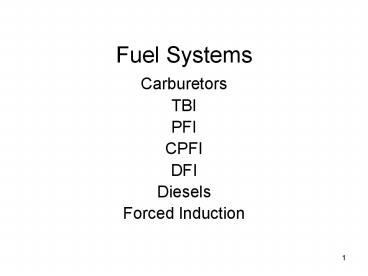Fuel Systems PowerPoint PPT Presentation
1 / 29
Title: Fuel Systems
1
Fuel Systems
- Carburetors
- TBI
- PFI
- CPFI
- DFI
- Diesels
- Forced Induction
2
Carburetors
- Mechanical devices that use pressure differential
to meter and vaporize fuel for engine demands - Contains 6 circuits designed to deliver air/fuel
mixture for different operating modes - Float/choke/idle/acceleration/main/power
- Mounted on top of intake manifold
- Receives fuel from mechanical pump driven by
camshaft
3
Carburetors
- Low fuel pressure 3-5 psi
- Fuel is vaporized inside venturis and travels
through intake manifold to cylinders - 4 cyls 1-2 venturis (barrels)
- 6 8 cyls 2-4 venturis
- 80s 90s
- Higher fuel costs
- Increasingly tight emission laws
- Onboard computers
4
TBI (Central Fuel Injection)
- 1 or 2 injectors mounted inside throttle body on
top of intake manifold - Injector is a simple on/off valve controlled
(pulsed) electronically by onboard computer (ECM) - Fuel is sprayed into intake stream above throttle
plate- vaporization takes place inside throttle
body - Uses tank mounted electric fuel pump
- Low pressure 10-15 psi
- Eliminates possibility of vapor lock
5
TBI
6
TBI
- Advantages
- Simplicity
- Low manufacturing cost
- Low cost of maintenance
- Disadvantages
- Fuel traveling through intake manifold
- Difficult to meter mixtures to individual
cylinders
7
PFI
- One injector per cylinder
- Injector is mounted in intake port in manifold or
cylinder head - Injectors are connected by fuel rail
- Injectors can be controlled as groups or
individually - Higher pressure 30-50 psi
- Necessary to break up fuel particles
- Vaporization takes place in front of intake valve
8
PFI
9
PFI
- Electric fuel pump mounted inside fuel tank
- Fuel pressure in fuel rail is regulated and
excess is returned to fuel tank - Fuel filter is usually mounted under body of car
- Throttle body controls air only
10
PFI
- Advantages
- Precise control of fuel mixtures to cyls
- No fuel traveling through intake manifold
- Disadvantages
- Higher cost of manufacturing complexity
- Higher cost of maintenance
- Injector location causes deposits
11
CPFI
- Designed as a hybrid system
- Allows for precise fuel control of PFI
- Simplicity of TBI
- Uses central injector mounted inside intake
manifold - Injector connects to nozzles that feed individual
cyls - Injector is electronically actuated
- Nozzles are activated by pressure
12
CPFI
13
CPFI
- Advantages
- Simplicity allows for low production cost
- Low cost of maintenance
- While unit is located inside intake manifold,
fuel is injected at intake port - Disadvantages
- Extremely sensitive to pressure changes
- Plastic lines that connect injector with nozzles
are prone to breakage
14
DFI
- Injector sprays fuel directly into combustion
chamber - Uses much higher pressure 2000-3000 psi
- Fuel must overcome compression pressures
- Vaporization must take place during injection
- Uses electric feed pump inside fuel tank
- Uses mechanical high pressure pump to increase
fuel pressures
15
DFI
16
DFI
- Advantages
- Allows for complete air fuel mixture control
- Better atomization from higher pressures
- Vaporization process cools combustion chambers
allowing higher compression ratios - Disadvantages
- Complexity
- High cost of manufacture and maintenance
- High pressure fuel pump
17
Diesel Systems
- Diesel fuel is heavier and requires much higher
temperatures to ignite - Engine is designed to create high heat with
compression - Fuel is injected once air is heated from
compression - Ignition occurs once fuel is injected into
chamber - Compression ignition engine
18
Diesels
19
Diesels
- Fuel is injected directly into combustion chamber
with precise timing - Uses very high pressures to overcome compression
pressures and to provide atomization of fuel - Most systems use electric in-tank pumps to supply
high pressure injection pumps - Injection pressures can be created by pumps or
injectors themselves, both driven by engine
camshaft
20
Diesels
- Pressures
- Supply pressures 5 to 75 psi
- Injection pressures 3000-40000 psi
- Injection timing is critical for
- Power
- Noise
- Smoke
- Air is unthrottled
- Engine speed is controlled by fuel delivery alone
- Engine acceleration is slower than spark ignition
engine
21
Diesels
- Advantages
- Extremely high engine output (torque)
- Higher energy content of fuel allows for better
economy - Disadvantages
- Higher emissions caused by high combustion
chamber temperatures - High compression ratios require expensive
internal engine components - Fuel systems components are precision and
expensive - Different operating characteristics slower
acceleration
22
Diesels
23
Diesels
24
Superchargers
- Uses engine power to pressurize intake manifold
- Boost pressures on stock engines 7-10 psi
- Forces more air into engine creating more power
- Usually found on V-type engines
- Simplified plumbing
25
Superchargers
26
Turbochargers
- Exhaust driven turbine forces air into intake
manifold - Same operating principles as supercharging
- Usually found on inline engines
- Plumbing complexity
27
Turbochargers
28
Intercoolers
- Cools compressed air going into intake manifold
- Cooler air more dense charge
- More air more power
- Cooler is mounted in front of radiator and
transfers heat to ambient air
29
Intercoolers

